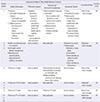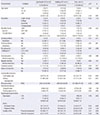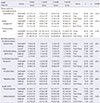Abstract
Purpose
To compare the effects of the Interaction Model of Client Health Behavior (IMCHB)-based oral health program (OHP) and walking exercise program (WEP) on oral health behaviors, periodontal disease, physical activity, and psychological indicators (depression, stress, and quality of life) in pregnant women.
Methods
A nonequivalent control group pretest-posttest design was adopted to compare the effects of a 12-week OHP and WEP on pregnant women (n=65). Pregnant women were randomly assigned to the oral health group (OHG; n=23), walking exercise group (WEG; n=21), or control group (CG; n=21). Data were analyzed by the χ2-test, Fisher's exact test, Scheffe test, and repeated measures ANOVA, using the Statistical Package for the Social Sciences for Windows (version 21.0).
Figures and Tables
Table 1
Action Plans of Cox's Interaction Model of Client Health Behavior (IMCHB) for Oral Health and Walking Exercise Groups

Notes
References
1. Public Oral Health Textbook Development Committee. Public health science. Seoul: Komoonsa;2016. p. 31–37.
2. Park HJ, Lee HJ, Cho SH. Influences of oral health behaviors, depression and stress on periodontal disease in pregnant women. J Korean Acad Nurs. 2016; 46(5):653–662. DOI: 10.4040/jkan.2016.46.5.653.

3. Jung YJ, Cho MH, Moon DH. Influencing factors to dental caries and periodontal diseases in Korean adults. J Korean Soc Dent Hyg. 2015; 15(1):47–54. DOI: 10.13065/jksdh.2015.15.01.47.

4. Giannella L, Giulini S, Cerami LB, La Marca A, Forabosco A, Volpe A. Periodontal disease and nitric oxide levels in low risk women with preterm labor. Eur J Obstet Gynecol Reprod Biol. 2011; 158(1):47–51. DOI: 10.1016/j.ejogrb.2011.04.034.

5. Vasiliauskiene I, Milciuviene S, Bendoraitiene E, Narbutaite J, Slabsinskiene E, Andruskeviciene V. Dynamics of pregnant women's oral health status during preventive programme. Stomatologija. 2007; 9(4):129–136.
6. Geisinger ML, Robinson M, Kaur M, Gerlach RW, Griffin R, Geurs NC, et al. Individualized oral health education improves oral hygiene compliance and clinical outcomes in pregnant women with gingivitis. J Oral Hyg Health. 2013; 1(2):111. DOI: 10.4172/2332-0702.1000111.
7. Cibulka NJ, Forney S, Goodwin K, Lazaroff P, Sarabia R. Improving oral health in low-income pregnant women with a nurse practitioner-directed oral care program. J Am Acad Nurse Pract. 2011; 23(5):249–257. DOI: 10.1111/j.1745-7599.2011.00606.x.

8. Ha MJ. The effect of the oral education program on the dental hygiene awareness and practice of the pregnant women [master's thesis]. Busan: Department of Nursing Graduate, Inje University;2011. 1–70.
9. Kang BW, Kim GS, Kim YH, Moon SE, Sung MK, Lee HS, et al. Preventive dentistry. Seoul: Komoonsa;2016. p. 95–125.
10. Woo HS, Kim DK. The effect of TBI on PHP index of workers need scaling. J Korean Acad Oral Health. 2010; 34(1):65–71.
11. Vamos CA, Thompson EL, Avendano M, Daley EM, Quinonez RB, Boggess K. Oral health promotion interventions during pregnancy: A systematic review. Community Dent Oral Epidemiol. 2015; 43(5):385–396. DOI: 10.1111/cdoe.12167.

12. Committee on Obstetric Practice, The American College of Obstetricians and Gynecologists. ACOG Committee opinion No. 650: Physical activity and exercise during pregnancy and the postpartum period. Obstet Gynecol. 2015; 126:e135–e142. DOI: 10.1097/AOG.0000000000001214.
13. Taniguchi C, Sato C. Home-based walking during pregnancy affects mood and birth outcomes among sedentary women: A randomized controlled trial. Int J Nurs Pract. 2016; 22(5):420–426. DOI: 10.1111/ijn.12453.

14. Kim J, Ahn ES. Association of periodontal status with health lifestyle in adults. J Dent Hyg Sci. 2015; 15(1):83–89.

15. Han KD, Park JB. Association between oral health behavior and periodontal disease among Korean adults: The Korea national health and nutrition examination survey. Medicine. 2017; 96(7):e6176. DOI: 10.1097/MD.0000000000006176.
16. Nascimento SL, Surita FG, Godoy AC, Kasawara KT, Morais SS. Physical activity patterns and factors related to exercise during pregnancy: A cross sectional study. PLoS One. 2015; 10(6):e0128953. DOI: 10.1371/journal.pone.0128953.

17. Joo HS, Kim CB, Nam EW, Lee MY, Park MB. Comparison of health-related behaviors in pregnant women and breast-feeding mothers vs non-pregnant women. Korean J Women Health Nurs. 2014; 20(3):185–194. DOI: 10.4069/kjwhn.2014.20.3.185.

18. Evenson KR, Moos MK, Carrier K, Siega-Riz AM. Perceived barriers to physical activity among pregnant women. Matern Child Health J. 2009; 13(3):364–375. DOI: 10.1007/s10995-008-0359-8.

19. Cox CL. The interaction model of client health behavior: Application to the study of community-based elders. ANS Adv Nurs Sci. 1986; 9(1):40–57.
20. Oh JY, Yang YJ, Kim BS, Kang JH. Validity and reliability of Korean version of international physical activity questionnaire (IPAQ) short form. J Korean Acad Fam Med. 2007; 28(7):532–541.
21. Radloff LS. The CES-D scale: A self-report depression scale for research in the general population. Appl Psychol Meas. 1977; 1(3):385–401. DOI: 10.1177/014662167700100306.
22. Chon KK, Lee MK. Preliminary development of Korean version of CES-D. Korean J Clin Psychol. 1992; 11(1):65–76.
23. Lee J, Shin C, Ko YH, Lim J, Joe SH, Kim S, et al. The reliability and validity studies of the Korean version of the perceived stress scale. Korean J Psychosom Med. 2012; 20(2):127–134.
24. Ahn HL. A pilot study of stressor and stress situation and nursing intervention of pregnant woman. J Nurs Acad Soc. 1983; 13(3):75–85. DOI: 10.4040/jnas.1983.13.3.75.

25. Ware J Jr, Kosinski M, Keller SD. A 12-Item Short-Form Health Survey: Construction of scales and preliminary tests of reliability and validity. Med Care. 1996; 34(3):220–233.
26. Choi HY, Yang SJ. Effects of walking program based on social cognitive theory for office workers. Korean J Adult Nurs. 2013; 25(6):712–724. DOI: 10.7475/kjan.2012.24.6.712.

27. Lee KO, Kim KR, Ahn SH. Effects of a qigong prenatal education program on anxiety, depression and physical symptoms in pregnant women. Korean J Women Health Nurs. 2006; 12(3):240–248.

28. Kim HM. The effect of walking exercise on the improvement of housewives’ self-esteem, stress, depression in terms of convergence. J Digit Converg. 2015; 13(12):453–460. DOI: 10.14400/JDC.2015.13.12.453.

29. Quandt SA, Hiott AE, Grzywacz JG, Davis SW, Arcury TA. Oral health and quality of life of migrant and seasonal farm-workers in North Carolina. J Agric Saf Health. 2007; 13(1):45–55.
30. Bang KS, Lee IS, Kim SJ, Song MK, Park SE. The effects of urban forest-walking program on health promotion behavior, physical health, depression, and quality of life: A randomized controlled trial of office-workers. J Korean Acad Nurs. 2016; 46(1):140–148. DOI: 10.4040/jkan.2016.46.1.140.





 PDF
PDF ePub
ePub Citation
Citation Print
Print







 XML Download
XML Download